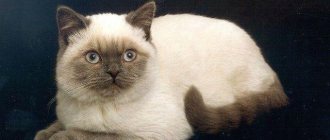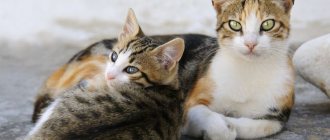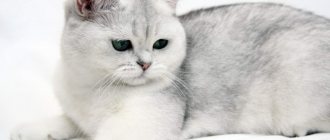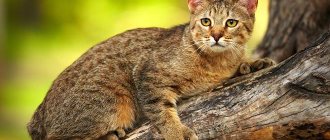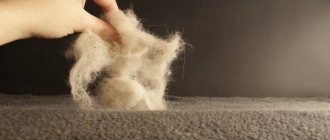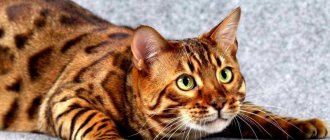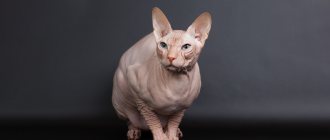The Siamese cat is a popular short-haired breed with a recognizable point color. Unique beauty is combined with sociability and intelligence. A good companion for those who value open expression of feelings and constant connection with their pet. These talkative cats will not let you get bored and will participate in all family activities.
| Breed | Siamese cat |
| Type | Siamese-oriental (eastern) group |
| Country of origin | Thailand |
| Coat | Shorthair |
| Lifespan | 15 – 25 years |
| Kitten price | 8000 – 35000 rubles |
History of the origin of the Siamese breed
The Siamese cat is one of the oldest and most famous cat breeds. Despite this, the origin of Siamese cats is still considered a mystery.
- The manuscript "Book Poems about Cats", dating back to 1350 - 1700, discovered in ancient Siam (modern Thailand), describes a pale cat with a dark coloration of the face, paws, ears and tail.
- According to legend, the Siamese were considered sacred. When a member of the royal family died, his soul was possessed by a Siamese cat, which then lived in the temple in luxury with monks and priests as servants. The theft and killing of a Siamese cat was punishable by death.
- Uncontrolled crossbreeding of Siamese in the 19th and 20th centuries led to cats no longer meeting the breed standard. Modern Siamese have become thinner and have acquired a characteristic triangular muzzle.
Subsequently, Siamese cats quickly became popular in different countries. This breed was first seen in Europe in 1871 at the London Cat Show. In 1879, a Siamese cat was given to the wife of the US President. The Siamese Cat Club was formed in 1901 in Great Britain, and the Cat Fanciers' Association (CFA) recognized the breed in 1906.
Related breeds:
- Oriental cat.
- The Balinese cat is a semi-longhaired Siamese cat.
- Burmanskaya.
- Thai is a restored Siamese breed according to the old type standard.
- The Himalayan is a long-haired breed developed by crossing Siamese and Persians.
Differences between Siamese and Thai breeds
How to care for Siamese cats
Caring for a Siamese cat will not require much of your time. These animals are quite independent, have good health and short hair. So you will have to make minimal efforts to keep your pet in good health.
Hygiene: bathing, brushing, nail trimming, cleaning ears and teeth
Siamese cats have different attitudes towards bathing, but even if the animal likes water procedures, there is often no need to carry them out. Optimally - once every six months, using any high-quality or specific shampoo prescribed by a veterinarian. When bathing, the main thing is to ensure that water does not get into the animal’s ears.
Special care for the Siamese's coat is also not required - it is enough to stroke the animal with a damp palm once every couple of days. This way you can quickly and easily remove excess hair. During periods of seasonal shedding, you can carefully comb your pet using a brush with fine natural bristles in the direction of hair growth.
In general, Siamese cats are quite favorable towards bathing and other hygiene procedures.
You can trim your nails once every two weeks, cutting off about 2 mm with nail clippers. The main thing is not to touch the pinkish core of the claw - it is clearly visible.
You can clean your ears once a week. Ordinary ear swabs are perfect for cleaning; a cotton swab should be soaked in a special antiseptic from a pet store or ordinary hydrogen peroxide. Before cleaning, excess antiseptic from the swab must be squeezed out. Cleaning is done carefully, without unnecessary effort. The inner cavity of the ear should be clean and pinkish in color.
Veterinarians strongly recommend brushing your Siamese's teeth because this breed is naturally prone to dental problems. Brushing your teeth will help avoid them. This procedure is performed once a month using a special toothbrush and toothpaste, which you can also buy at a pet store.
With proper care, Siamese cats can live more than 20 years.
Features of toilet organization
There are really no special features. Choose a closed tray or one with high edges so that the animal does not scatter the filler while burying.
Choose the filler itself based on your budget, personal experience and animal preferences. If you find it difficult to choose, try all the types available in the supermarkets where you usually shop. The optimal option will thus be determined experimentally. You can start such experiments with clumping clay or silica gel fillers - they retain odor well and are economical in consumption.
Features of catering
Nutrition is very important! The quality of food directly affects the health of your cat.
Experts recommend feeding animals only with industrial super-premium or holistic food. Such a diet may look “monotonous” from a human point of view, but it saturates the cat’s body with all the necessary substances, vitamins and microelements, being optimally balanced in composition. You cannot achieve this quality of nutrition by cooking your own food. Among the foods, you can give preference to super-premium or holistic foods from Acana, Purina, Schesir, ProNature or Applaws. Portions are usually indicated on the packaging. Before purchasing, also study the composition of the food - it should not contain grains or gluten, and protein should come first among the ingredients.
Homemade food is an extra waste of time, effort and money, while industrial food feeds the animal’s body with all the necessary elements, saving your resources
Description of the Siamese breed
Let's look at the appearance and character of Siamese according to the breed standard.
Standard
Siamese cats are well balanced, boasting an athletic, flexible body and elegant, slender legs.
The breed standard for the modern Siamese cat assumes:
- Body: Elongated, tubular and muscular. A typical Siamese cat has a total height of 20-25 cm and a body length of 29-36 cm, with a body weight of 4-5 kg.
- Head: Straight profile with a strong chin and a pleasant, even bite. The head forms a perfect triangle from the tip of the nose to each tip of the ear. The neck is long. The eyes are almond-shaped, bright blue, and the ears are large, wide, located closer to the head.
- Limbs: The cat's hind legs are longer than her front legs, which adds to her athletic and graceful appearance. The paws are oval shaped and small. Thin tail.
- Coat: Short, shiny, fine coat without undercoat that lies close to the body.
Today, there are over 20 varieties of Siamese cat colors all over the world, and the most famous of them are:
- Seal point (brown or cream), with a cream-colored body and dark brown pigments on the nose and paws. It is believed that this was the original color of the breed when it was first exported from Siam (Thailand).
- Blue Point (blue) - the body is snow-white with a bluish tint, as well as a gray nose and paws.
- The Red Point is a white body with red (apricot) pigments on the nose and paws.
- The Caramel Point (light cream) is considered a hybrid due to a complex breeding process, with very light and pink pigments on the nose and paws.
- Chocolate point (black). The body is cream or milky in color, and the pigments on the points can range from chocolate to black.
- Cinnamon point (ivory). The body is ivory-colored, like a Chocolate Point, but the markings on the nose and paws are pinkish-brown.
Photos of colors
Seal Point
Blue Point
Red tabby point
Caramel point
Chocolate Point
Cinnamon Point
Kinds
The classic Eastern Oriental group of the Siamese breed includes the following varieties.
- The Siamese is a short-haired cat with a narrow wedge-shaped head, pointed ears and blue eyes. The body is thin, proportional, legs and tail are long. These cats are very beautiful and are one of the favorite breeds of many breeders. They have a combination of white and cream coats with dark brown points.
- Thai species - considered the standard of the original breed that existed in Thailand. They differ from the Siamese species in that all the lines and proportions of the body have rounded and smoother lines.
- Oriental appearance - the body has the same structure and proportions as that of the Siamese species, but with the difference that the color of cats is uniform gray or black, spots may sometimes be present, but this species does not have points in color. This species was introduced along with the Siamese, but did not excite breeders and was not so widespread.
- Mekong Bobtail - the color and structure resembles the Thai species, but the bobtail has a tail that looks like a stump, consisting of several vertebrae.
Modern breeding species of Siamese cats may vary in color characteristics.
Brown seal point - the overall body color of the cat is light cream, and the points have a dark chocolate shade of color.
Character of Siamese
Siamese are known for being one of the most intelligent and vocal cats in the world and will happily spend time with their owners. Siamese cats are affectionate with domestic cats, however, they can be demanding and suspicious of strangers. Many people say that their Siamese pets greet strangers at the door and go through some kind of approval process before visitors enter the house.
At the same time, Siamese cats are very active and love active games with toys. When it comes to training, they do not have any special exercise needs because Siamese cats are very active and playful in their own right.
They quickly get accustomed to the litter box and scratching post; the main thing is not to shout or force the cat to do anything. Siamese are quite proud and can become stubborn from such treatment. You can even toilet train them if you start training them when they are young.
You should not get a Siamese cat if you are often away from home. The pet will get bored and entertain itself in any of the available ways.
The stereotype about the evil character and vindictiveness of the Siamese, as a distinctive feature of the breed, originated in the USSR. The price of a purebred Siamese cat was high, so we usually received rejected kittens with squints, creases in the tail and abnormalities.
Information for owners
Siamese fluffy cats are considered one of the most affectionate, intelligent and friendly cat breeds. According to the description, they are distinguished by their special affection for their owners, they love to participate in their activities, pose for photos, and sometimes even “talk” to their owners with a pleasant and gentle purr.
By the nature of the sounds that a furry pet makes, you can judge its mood.
Siamese cats, as written above, require increased attention from their owners. Keep this in mind if you plan to have another similar cat of a similar breed in the same building. Also, these creatures live well with other cats in the same building (not cats of the same breed). These fluffies love to play with children and are always full of energy, which is why kids adore them. In our photo, fluffy Siamese cats are shown in all their glory.
Health
With proper care and nutrition, the average lifespan of Siamese cats is 15-25 years.
They may also have problems with progressive retinal atrophy, which can lead to poor vision and even blindness. Glaucoma and strabismus are also common among eye diseases.
This breed is more prone to lung infections than others. The most common condition is asthma, which causes inflammation and narrowing of the lungs' airways.
These cats are known to have very sensitive stomachs. In addition, Siamese cats may have problems with the heart, kidneys and liver.
Advantages and disadvantages of the breed
The positive characteristics of Siamese cats include:
- Magnificent mind.
- Excellent trainability.
- Loyal to their master.
- They have an attractive appearance. This can be seen by looking at a photo of a Siamese cat.
- They get along well with the smallest members of the family.
- Practically not subject to shedding.
- Playful and cheerful.
Pets also have disadvantages:
- Siamese are very touchy and can remember bad things for a long time.
- They are independent and have willful characteristics.
- Demanding about cleanliness.
- They do not tolerate cold well.
- They have a fairly loud voice.
- They are jealous and cannot tolerate cohabitation with other animals.
Breed card
| Characteristics of a cat | Notes | |
| General information | An ancient cat breed known for its pointing color, playfulness and ringing voice. Extroverts by nature | Modern Siamese are the result of restoring the standard of an ancient breed. And those yard cats, which in Russia are usually mistaken for Siamese, are representatives of the Thai breed |
| Character | Siamese require their owner's attention constantly. They have an affectionate nature and are quick-witted, but can be stubborn | Purchase various toys in advance so that your pet always has something to occupy himself with. The best solution would be to purchase a play set for cats |
| Appearance | A medium-sized cat with a slender, athletic body, an elongated wedge-shaped head, large ears, and blue or blue eyes. Kittens are born completely white. Points (areas of dark fur) develop as the dog matures, with the sides usually being the last to darken. The final color is formed by 2 years of age. | Strabismus and creases in the tail are a defect in the breed. If you are offered a kitten with green or yellow eyes, then this is not a Siamese, but perhaps an Oriental. |
| Behavior at home | Active breed. They love to climb and play. Very talkative, especially cats during mating season | Siamese are sexually horny cats, so their puberty begins earlier than other breeds. You can castrate your pet at the age of 4-5 months. |
| Care | Minimal maintenance as there is no undercoat. Combing once a week. A scratching post is required | |
| Health problems | Among the congenital defects there is strabismus. Modern Siamese have problems with tail kinks and respiratory problems | Food allergies to cow's milk are common |
How much money do you need for care and maintenance?
What to buy for a kitten
Required set:
- Two or three bowls (depending on the type of feeding). Choose a large water bowl - Siamese often like to drink from large containers. Price: 150 – 320 rub.
- Tray. Large with deep sides: 250 – 1350 rub.
- Wide-toothed comb or brush with natural bristles: RUB 350 – 650.
- Scratching post: 900 – 2500 rub.
- Toys. Choose intellectual ones and those that you can run after. Price: 600 – 3500 rub.
- Plastic carrier with metal door. Price: 1250 – 2600 rub.
- Bed. Warm with sides: 500 – 2000 rubles.
Additional products:
- Vertical game complex. Price: 5000 – 32000 rub.
- Claw cutter. Price: 350 – 590 rub.
- Harness with leash. Price: 850 – 1600 rub.
- Anti-cat bars for windows. Price: 1800-2450 rub.
- Automatic drinking fountain. Some Siamese cats love to drink running water. Price: 1800 – 4800 rub.
The annual care of a Siamese cat may require from 20 to 40 thousand rubles.
The budget will depend on your capabilities, the chosen diet, the type of filler and the health of the pet.
Care
They are incredibly clean and don't shed much, so caring for them is not particularly difficult.
Wool
Even though Siamese cats have short hair, they need to be brushed weekly. Many fans of this breed recommend small rubber brushes. You need to comb in the direction of hair growth.
Most Siamese cats are very clean and clean themselves well, so you can bathe them no more than 2 times a year. However, when they are very dirty or have gotten into something sticky, they may need a little help.
Advice! Place a rubber mat in the sink or bathtub to prevent your cat from slipping.
Nutrition
In addition to basic veterinary care such as vaccination compliance and regular checkups, proper nutrition is important. Providing a proper diet can help prevent health problems in your pet later in life.
Advice! Don't forget to change the water and wash the bowls daily!
There are two options for feeding your pet: natural food and industrial food.
Natural nutrition
- Basic nutrition – animal proteins:
- Lean meats (chicken, rabbit, lean beef and turkey).
- Sea fish and seafood (tuna, cod, shrimp) - as a source of healthy fats and taurine.
- Eggs (preferably quail) – no more than once a week.
- Beef liver and offal - tripe, udder, lips, chicken necks.
- Carbohydrates and fats
:- Fermented milk products - cottage cheese, ryazhenka kefir, yogurt without additives.
- Vegetables and greens - zucchini, carrots, spinach, pumpkin, broccoli, peas, beets.
- Porridge – buckwheat, millet, oatmeal, rice.
- Linseed oil.
- Vitamins – additional vitamin complexes are required for natural nutrition. Main additives: taurine, tetravit, calcium and yeast as a source of B vitamins.
Important! Red meat and liver can darken light fur, so you should not make such foods the main food for show cats.
Industrial feed
The basic rule is not to feed your pet economy-class food. The ideal option would be brands from the super-premium and holistic categories. We have previously compiled ratings for dry and wet cat food.
Recommended brands:
- Orijien Fit & Trim.
- Acana Light & Breed.
- Go Natural.
- Eukanuba Sterilized.
- Bosch Sanabelle.
- Royal Canin “Sterilized 37”.
Sometimes cats are allergic to grains, cow's milk and poultry. In such cases, it is necessary to switch to grain-free lines such as Natural & Delicious, which are free of rice, corn and chicken.
Adult pets with certain diseases (diabetes, urolithiasis, renal failure and heart pathologies) are transferred to specialized veterinary nutrition. A good line of medicinal foods is represented by the Hill's Prescription Diet brand.
Vitamin-mineral complexes are not needed, because manufacturers necessarily include all the compounds necessary for the body in the feed.
Caring for ears, eyes, teeth and claws
- If possible, you should brush your cat's teeth 2 times a week. We revealed all the nuances of this simple procedure in this article.
- The almond shape of the eyes allows pus and tear fluid to accumulate in the corners, so be sure to wipe your eyes with a damp cotton pad as needed.
- Ears should be wiped with a barely damp cotton pad once a week. If you notice black spots, crusts and an unpleasant odor, take your pet to the doctor. The most common cause of such symptoms is ear mites, which are easily eliminated in the initial stages. If left untreated, it can lead to hearing loss.
A visit to the veterinarian every year is mandatory for keeping a Siamese cat. Examinations provide an opportunity to early detect health problems, including those that may change your cat's care needs. For example, viral diseases, eating disorders, heart and kidney problems.
The frequency of visits to the veterinarian depends on the age of the pet:
- kitten 1-4 months – monthly visits;
- 4 months to 7 years – 1-2 times a year;
- 7-10 years – twice a year;
- over 10 years old - visit every 3 months or more often, as age-related health problems only increase.
Walking your pet
Siamese cats are ideal pets for both apartments and country houses. They are perfectly adapted to travel and trips, because the main thing for these creatures is the presence of their beloved owner nearby. Cats are good travel companions when they are happy. Your job is to figure out how to make their journey comfortable. Bring your favorite bed, litter box, toys, food and litter box.
They can also be easily trained to walk outside in a harness or in a walking carrier.
FAQ
How many live at home?
Cats living in a family can live a long life - 15-25 years. Among the representatives of the breed there are long-lived cats that have lived for more than 35 years.
What is the weight of an adult and a kitten?
Siamese cats are slightly larger than females. At three months, cats weigh 1-1.5 kg, females - 1.3-2.8 kg. By six months, cats reach a weight of 1.7-2.4 kg, males - 2.3-4.1 kg. Adult females weigh 3.1-4.2 kg, males - 4-6.1 kg.
Is it easy to hold?
Siamese are affectionate and gentle towards their people. They can walk on their hands and sit on their knees. There are individuals who greet you at the doorstep and ask to be held in your arms. They may not go to strangers.
Can I keep it outside?
No. These cats are very sensitive to cold. They cannot be kept even in a cold room.
How aggressive is the breed?
The aggressiveness of Siamese cats is legendary. But these are just legends. True purebred Siamese are affectionate pets that become attached to people. The myth of vindictiveness and aggressiveness appeared in the Soviet years, when cats with genetic defects and psychological problems were imported into the country. Modern purebred Siamese are smart, willful, but not aggressive.
Do they like to claw/climb?
They love you if they are bored. Don't leave your pets alone for long periods of time and provide them with toys they can play with while you're away.
Is this breed hypoallergenic?
The short-haired Siamese poses a potential danger to allergy sufferers. The Balinese cat, which is sometimes called the longhaired Siamese, is considered less allergenic and is related to the Siamese.
Do you need to take care of your fur?
Minimal grooming is required - the breed has short hair without undercoat. Some owners simply run a damp hand over the animal's fur to remove dead hair. You can brush your Siamese once a week with a natural bristle brush or a sparse comb.
What color are eyes?
Cats of this breed have rich blue or blue eyes. Do not believe those who offer you a purebred Siamese cat with a different eye color. Green, copper and yellow colors are a breed defect.
Is the breed prone to heart disease?
Unfortunately, Siamese cats have a hereditary predisposition to heart pathologies. Such as heart enlargement and aortic stenosis.
At what age do they stop growing?
Siamese kittens reach adult size by 2 years. By this time, the color of the coat and eyes should have finally formed. In some individuals, the growth process is completely completed at 1.5 years.
Reviews from Siamese cat owners
Kirill : “I named my Siamese cat Klitschko. Moreover, initially he was Piglet, but the fighting qualities of the cat determined his name and future fate. They say that Siamese cats are fighters. They say the truth. But, respecting my cat, I will say that people have never suffered from his long claws, but furniture and curtains have suffered regularly! Klitschko, my friend, is stubborn. He immediately refused to eat ready-made food, even though I offered him the most expensive options, he only eats human food, including bread and butter and caramels. I know it’s harmful, but that’s how it happened historically.”
Nikita : “When the blue-eyed kitten from the entire litter jumped into my arms, the bearded engineer’s heart trembled. I named it Pepper, in the hope that it will grow into a cool pepper. Pepper is still growing. What can I say - the character, like all Siamese, is sharp. Firstly, he decided that the bathroom was a wonderful toilet, large and white, and so far he could not be dissuaded. Secondly, this impudent guy only sleeps on my head. It feels like I'm growing another beard at night. But that's where its shortcomings end. Perchik is a real man’s cat, brutal and childish at the same time.”
Slava : “Very often cats with a similar color are called Siamese. This is where the myth about their aggressiveness, vindictiveness and sloppiness came from. In fact, true Siamese cats are an elegant breed in every sense. They are delicate and unobtrusive, even when they miss their owner, Siamese cats do not beg for affection, but intelligently wait for it. Of course, familiarity is not in their favor, but if you remember this, you can build a wonderful partnership with your Siamese cat.”
Video reviews:
How to choose a kitten
When choosing a Siamese kitten, the most important things are its health and pedigree. Therefore, it is imperative to see the kittens’ parents and find out about their general health. Any mention of heart or liver problems in either parent should be noted as these can be passed on to the kittens.
You should also look at the place where the kittens are kept to make sure that they are free of dirt, fleas and ticks. Siamese kittens are social and quite dependent on their parents.
Therefore, kittens should not be weaned from their mother before 12 weeks of age, otherwise they may develop severe anxiety disorders.
You may notice that the kittens are either creamy white or lighter in color than expected. This is fine. The face, paws and tail darken at about 4 weeks of age and continue to darken until the kittens are 1-2 years old. The size of the points directly depends on the temperature of the habitat. The lower the temperature, the more the coat darkens.
That's why newborn kittens, warm from their mother's womb, are white everywhere. Then, as they grow at normal temperatures, the hottest area of their body, around the belly and back area, remains pale while the limbs gradually become darker. And in an adult cat, the general body temperature begins to drop somewhat, and over time the fur darkens more and more.
As for the cost of a kitten , this indicator depends on the following factors: age, pedigree, health status, availability of vaccinations, travel box, toys, etc. Also of great importance is the owner's guarantee that her parents do not suffer from any serious diseases that could be inherited by the kitten.
- The price of a pet-class kitten (pet) is 3000-8000 rubles.
- Breeding class (breeding) – 10,000-15,000 rubles.
- Show class (show kittens) – the price depends on the nursery, from 30,000 rubles and above.
How much does a Siamese kitten cost?
The average price for a Siamese kitten is 8,000 – 35,000 rubles (5,000 – 10,000 UAH).
What does the price depend on?
Price formation is influenced by:
- kitten class;
- floor;
- colors;
- age;
- prestige of the nursery;
- parents' titles;
- sale with or without breeding rights;
- pedigree.
The biggest influence on the cost is belonging to a certain class:
- SHOW (show) – kittens are sold with the right to breed and are allowed to participate in exhibitions and competitions. Price: from 25,000 to 45,000 rubles;
- BREED - healthy kittens without genetic pathologies and good characteristics, have minor deviations from the standard, can be exhibited and allowed for breeding. They cost from 10,000 to 15,000 rubles.
- PET (pet) - pets without the right to breed, are not allowed to exhibitions. Price: from 3,000 to 10,000 rubles.
Breeding
If you decide to start breeding a Siamese cat, the first step is to find a healthy male. Of course, the best way to do this is to contact the owner of a nursery near where you live. A Siamese cat owner with a good pedigree will be happy to help you in this matter, as he knows how important it is to keep the blood lines pure and reduce the risk of any hereditary problems.
When choosing a breeding cat for your Siamese breed, consider the following factors:
- Is this the first time your female will be mating? If the answer to this question is yes, then you should think about having an experienced male.
- Have you had all the necessary tests? Before you take your cat for mating, you should arrange a visit to the veterinarian to confirm the absence of hereditary and viral diseases.
- What are you going to do with the kittens? When choosing a breeding cat, you need to make sure that you can sell the kittens in the future.
Pregnancy in Siamese cats is slightly shorter than other breeds - 58-65 days. On average, a Siamese cat gives birth to 4 to 6 kittens. The colors of kittens can be predicted in advance by knowing the recessive and dominant genes for coat colors in both partners.
Siamese catteries in Russia
The Siamese breed is one of the most numerous, so finding a nursery is not difficult at all:
- "Orientville" - Moscow.
- "Siaorimania" - Moscow.
- "Jubatus" - Novocheboksarsk.
- "JUNGLE" - Moscow.
- "Eastward" - Moscow region.
- "EkstaSia" - Yekaterinburg.
Pregnancy and childbirth
Cats typically reach puberty at 8 months of age. But Siamese cats, which belong to the oriental type, enter this period earlier - at 4 - 5 months. The onset of sexual activity may be influenced by the time of birth of the animal. A woman born in the spring may demand a cat in the fall, and a woman born a little later will most likely begin to come into heat in the spring of next year. The ability to reproduce begins only at 10 months of age and continues until 8 years.
The average gestation period for Siamese cats is 65 days. Lambing that occurs before 60 days is considered premature. Kittens born at this time are considered non-viable. If labor does not begin on day 68, we can talk about post-term kittens, in which case you need to seek help from a veterinarian.
If the date of the tailed couple was successful, then in the first month the first changes in the appearance and behavior of the cat will become visible. At this time, there is a slight increase in weight. There may be loss of appetite and slight vomiting. After day 35, the cat’s tummy becomes rounded, the nipples turn pink and enlarge. There is an appetite and a desire to sleep longer. During this period, the cat’s life is almost no different from before, but too active games should be prohibited, although dosed activity is necessary. In the later stages, a pear-shaped tummy appears, and by placing your hand on it you can feel the kittens moving. 2 weeks before birth, the movements of the kittens in the womb are clearly visible when the tailed mother lies on her side. During this period, the animal's activity is significantly reduced. It is best to provide your cat with a cozy place to rest and not disturb her unnecessarily.
During pregnancy, the cat should feel comfortable
A week before the start of labor, take your pet to the veterinarian and agree with him so that qualified assistance is immediately provided in case of complications.
The behavior of the animal speaks eloquently about the approach of childbirth. The cat begins to actively look for a place to lamb. The loop enlarges greatly, and clear or light pink discharge appears. The tailed mother may completely refuse to eat. The animal becomes especially affectionate and demands attention to itself.
For lambing you need to prepare a special place, or better yet several. Any cardboard box with low sides will do so that the cat does not touch her stomach. The box is lined with a warm mattress or a blanket folded several times, over which a clean sheet (disposable or cotton) is laid. The nest is placed in a secluded place where households or pets do not look.
A naturally physically developed and healthy cat will cope with childbirth on its own. But your presence nearby is simply necessary, especially if the cat gives birth for the first time. Just be nearby so that the furry woman in labor feels your presence and support.
Just in case, prepare the necessary tools to assist the tailed woman in labor and her offspring. You will need:
- sterile gloves;
- sterile scissors with rounded tips;
- thread for tying the umbilical cord (catgut);
- clean diapers and towels for drying kittens;
- eye pipette for suctioning mucus from the respiratory tract of kittens;
- iodine;
- peroxide;
- cotton buds.
Keep your phone number and veterinarian number nearby in case you urgently need advice or help.
Once the kittens are born, you will need to monitor the temperature inside the nest. To do this, place a thermometer at the bottom of the box. During the first 3 days of life, kittens need to be warm, so keep the temperature around 29°C. This can be easily done by placing a heating pad under the mattress. Then, every week, reduce the temperature by 3°C, gradually bringing it to 21°C.
Newborn Siamese kittens - video
Interesting facts about the Siamese cat
- The color of their coat is determined not only by heredity. This breed has a special modifier gene that prevents the development of pigment in the fur, which leads to albinism.
- Siamese are considered one of the oldest cat breeds in the world.
- Legends say that in ancient times the first Siamese cats were tasked with guarding the royal cup. They looked at him with such intensity that their eyes crossed. For added security, the cats wrapped their tails around the cup, causing them to become permanently bent.
- Siamese cats have appeared in many Hollywood films.
Overall, this is the most affectionate cat breed you will find. She is very smart, obedient and friendly, and also loves and values human communication so much that she is even called a cat-dog.
Main characteristics
Thanks to the unique coloring, the Siamese cannot be confused with other individuals. Pets have deep blue eyes and a rather intelligent and expressive look.
The weight of an adult cat is usually 4-5 kilograms. Animals that have undergone sterilization or castration can weigh 7-8 kilograms.
The height of cats is small and is 23-25 centimeters at the withers. The length of the body does not exceed 60 centimeters.
The color of these animals is unique. The main part of their body is light, and the tail, paws and muzzle are dark.
If you provide your cat with proper care and proper nutrition, its life expectancy can be 25 years.
The character of the Siamese cat is independent and stubborn. Cats are friendly towards both adults and children. They become very attached to their owner.
The Siamese have a highly developed intelligence. They are smart, quick-witted and calculating.
Siamese cats are very sensitive to the mood of their owner and can show jealousy towards him.
Despite the craving for loneliness, Siamese love cheerful company and are able to attract attention.
Speaking about the character of the animal, it is worth mentioning its touchiness. Getting forgiveness from a punished or offended cat is not so easy.
Varieties of Siamese also include the Oriental, Mekong Bobtail and Thai Siamese.
When kittens start to get dark
All Siamese kittens are born albinos, but after a week characteristic spots begin to appear, by six months it becomes clear what the main color of a Siamese kitten is, and by the 10th month all shades are finally formed.
Dark shades appear on the paws, tail, ears and face. With age, the contrast intensifies.

